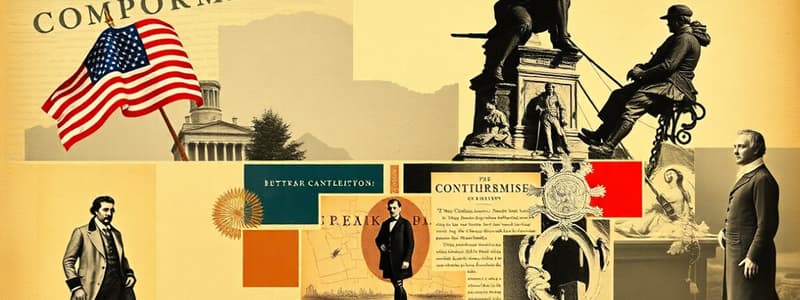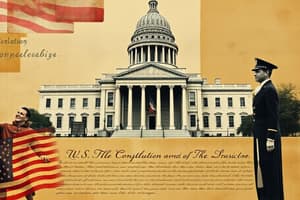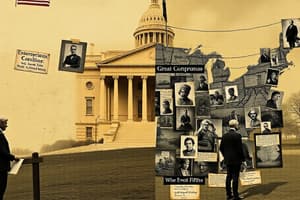Podcast
Questions and Answers
Which two plans were presented to discuss the roles of national and state governments?
Which two plans were presented to discuss the roles of national and state governments?
- Delaware Plan
- Pennsylvania Plan
- Virginia Plan (correct)
- New Jersey Plan (correct)
What is the agreement called that resulted from the delegates' discussions?
What is the agreement called that resulted from the delegates' discussions?
Great Compromise
In the Senate, states have representation based on their population.
In the Senate, states have representation based on their population.
False (B)
Which state was the first to ratify the Constitution?
Which state was the first to ratify the Constitution?
Who were two key figures in promoting the ratification of the Constitution through The Federalist Papers?
Who were two key figures in promoting the ratification of the Constitution through The Federalist Papers?
The Constitution became law when ___ of the thirteen states ratified it.
The Constitution became law when ___ of the thirteen states ratified it.
Match the plans with their characteristics:
Match the plans with their characteristics:
What were the two plans presented regarding the representation in Congress?
What were the two plans presented regarding the representation in Congress?
How many delegates signed the Constitution on September 17, 1787?
How many delegates signed the Constitution on September 17, 1787?
The first state to ratify the Constitution was __________.
The first state to ratify the Constitution was __________.
Which influential figures promoted the ratification of the Constitution?
Which influential figures promoted the ratification of the Constitution?
By what year had all thirteen colonies ratified the Constitution?
By what year had all thirteen colonies ratified the Constitution?
Flashcards are hidden until you start studying
Study Notes
The Founding Fathers and the Great Compromise
- Delegates to the Constitutional Convention debated the balance of power between the national government and individual states.
- Key issue: how to represent states in the new Congress, considering population differences.
- Two competing plans emerged:
- Virginia Plan: Favored larger states, proposing a bicameral legislature with representation based on population.
- New Jersey Plan: Supported smaller states, advocating for a unicameral legislature with equal representation for each state.
- The Great Compromise resolved the conflict:
- Created a bicameral Congress:
- The Senate: provides equal representation for each state, regardless of size.
- The House of Representatives: representation based on state population.
- Created a bicameral Congress:
Ratification and the Constitution
- The Constitution was signed by 39 delegates on September 17, 1787.
- Ratification by nine out of thirteen states was required for the Constitution to become law.
- Delaware was the first state to ratify, followed by Pennsylvania.
- Some opposed ratification, fearing the loss of state power.
- Influential figures like Benjamin Franklin, George Washington, James Madison, and Alexander Hamilton advocated for ratification.
- They used public arguments and publications like The Federalist Papers to sway public opinion.
- By 1790, all thirteen colonies had ratified the Constitution, establishing them as states.
The Great Compromise
- Delegates disagreed on the power relationship between national and state governments
- Different population sizes between states led to a debate regarding representation
- The Virginia Plan proposed a bicameral legislature with representation based on state population
- The New Jersey Plan favored a unicameral legislature with equal representation for each state
- The Great Compromise addressed the concerns of both plans, establishing a bicameral Congress
- The Senate has equal representation for each state, regardless of population
- The House of Representatives has representation based on state population
Ratification of the Constitution
- 39 delegates signed the Constitution on September 17, 1787
- Nine states needed to ratify the Constitution for it to become law
- Delaware was the first state to ratify
- Hesitation existed regarding the Constitution due to concerns about surrendering state power
- Influential figures like Benjamin Franklin and George Washington supported the Constitution, swaying public opinion
- The Federalist Papers, written by James Madison and Alexander Hamilton, advocated for ratification
- All thirteen colonies ratified the Constitution by 1790, becoming states
Studying That Suits You
Use AI to generate personalized quizzes and flashcards to suit your learning preferences.




